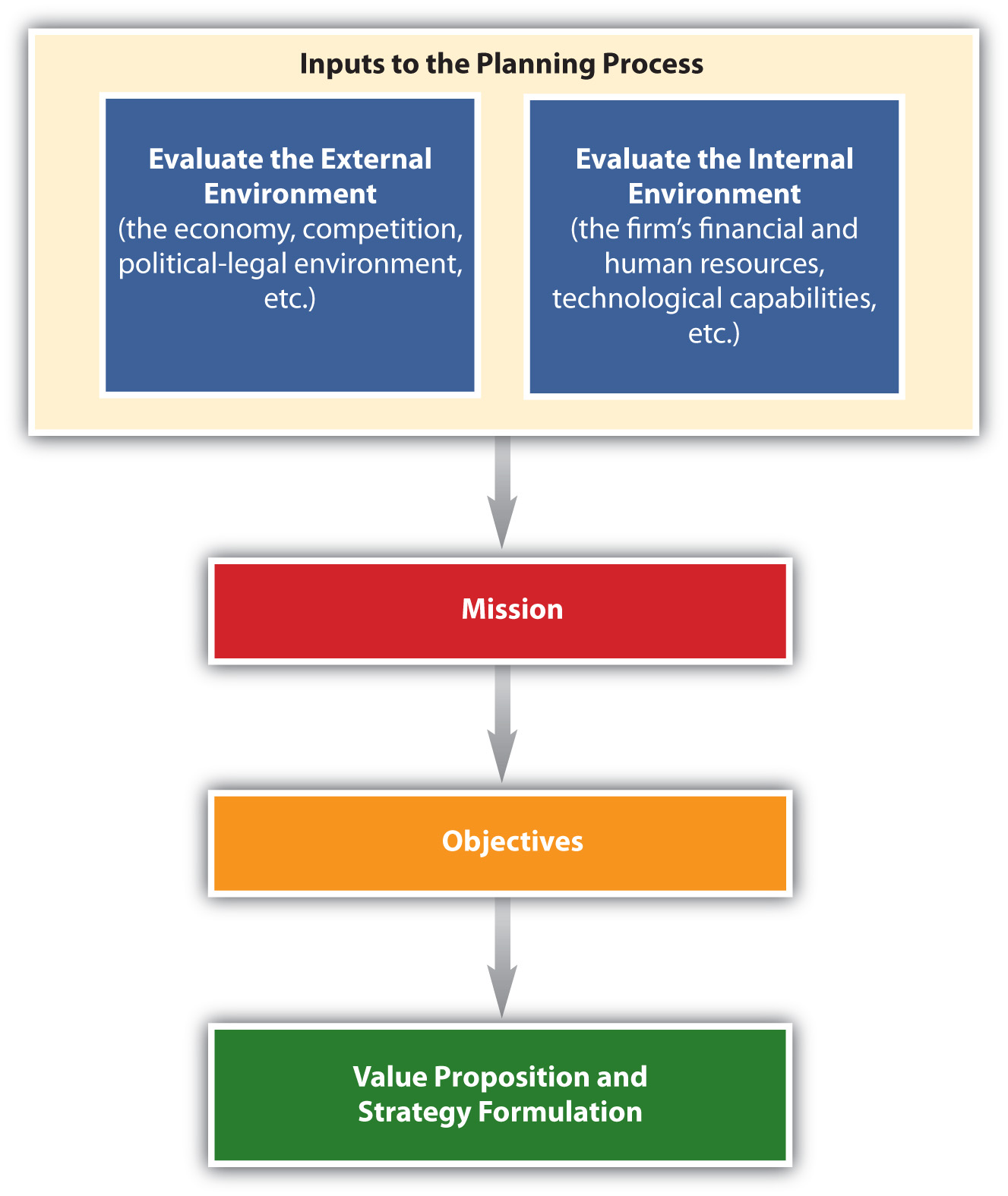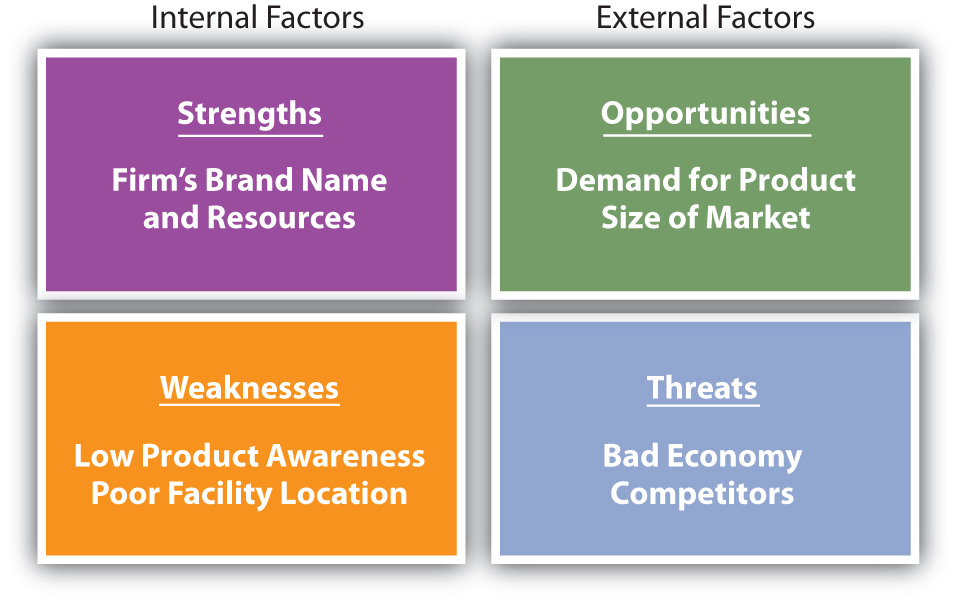Chapter 2: Marketing Environment and Planning
2.1 Components of the Strategic Planning Process
Learning Objectives
- Explain how a mission statement helps a company with its strategic planning.
- Describe how a firm analyzes its internal environment.
- Describe the external environment a firm may face and how it is analyzed.
Strategic planning is a process that helps an organization allocate its resources to capitalize on opportunities in the marketplace; typically, it is a long-term process. The strategic planning process includes conducting a situation analysis and developing the organization’s mission statement, objectives, value proposition, and strategies. Figure 2.1 shows the components of the strategic planning process. Let’s now look at each of these components.

Conducting a Situation Analysis
As part of the strategic planning process, a situation analysis must be conducted before a company can decide on specific actions. A situation analysis involves analyzing both the external (macro and micro factors outside the organization) and the internal (company) environments. Figure 2.2 shows examples of internal and external factors in a SWOT analysis. The firm’s internal environment—such as its financial resources, technological resources, and the capabilities of its personnel and their performance—has to be examined. It is also critical to examine the external macro and micro environments the firm faces, such as the economy and its competitors. The external environment significantly affects the decisions a firm makes, and thus it must be continuously evaluated. For example, during the global financial crisis of 2008, businesses found that many competitors drastically cut the prices of their products. Other companies reduced their package sizes or the amount of product in the packages. Firms also offered customers incentives (free shipping, free gift cards with purchase, rebates, etc.) to purchase their goods and services online, which allowed businesses to cut back on the personnel needed to staff their brick-and-mortar stores. While a business cannot control things such as the economy, changes in demographic trends, or what competitors do, it must decide what actions to take to remain competitive—actions that depend in part on their internal environment.
Conducting a SWOT Analysis
Based on the situation analysis, organizations analyze their Strengths, Weaknesses, Opportunities, and Threats or conduct what’s called a SWOT analysis. Strengths and weaknesses are internal factors and are somewhat controllable. For example, an organization’s strengths might include its brand name, efficient distribution network, reputation for great service, and strong financial position. A firm’s weaknesses might include a lack of awareness of its products in the marketplace, a lack of human resources talent, and a poor location. Opportunities and threats are factors that are external to the firm and largely uncontrollable. Opportunities might include the international demand for the type of products the firm makes, a small number of competitors, and favourable social trends such as people living longer. Threats might include a bad economy, high interest rates that increase a firm’s borrowing costs, and an aging population that makes it hard for the business to find workers.
You can conduct a SWOT analysis of yourself to help determine your competitive advantage. Perhaps your strengths include strong leadership abilities and communication skills, whereas your weaknesses include a lack of organization. Opportunities for you might exist in specific careers and industries; however, the economy and other people competing for the same position might be threats. Moreover, a factor that is a strength for one person (say, strong accounting skills) might be a weakness for another person (poor accounting skills). The same is true for businesses.

The easiest way to determine if a factor is external or internal is to take away the company, organization, or individual and see if the factor still exists. Internal factors such as strengths and weaknesses are specific to a company or individual, whereas external factors such as opportunities and threats affect multiple individuals and organizations in the marketplace.
Assessing the Internal Environment
As we have indicated, when an organization evaluates which factors are its strengths and weaknesses, it is assessing its internal environment. Once companies determine their strengths, they can use those strengths to capitalize on opportunities and develop their competitive advantage.
Coca Cola’s brand awareness, profitability, and strong presence in global markets are also strengths. In foreign markets in particular, the loyalty of a firm’s employees can be a major strength, which can provide it with a competitive advantage. Loyal and knowledgeable employees are easier to train and tend to develop better relationships with customers. This helps organizations pursue more opportunities.
Although the brand awareness for Coca Cola’s products is strong, smaller companies often struggle with weaknesses such as low brand awareness, low financial reserves, and poor locations. When organizations assess their internal environments, they must look at factors such as performance and costs as well as brand awareness and location. Managers need to examine both the past and current strategies of their firms and determine what strategies succeeded and which ones failed. This helps a company plan its future actions and improves the odds they will be successful. For example, a company might look at packaging that worked very well for a product and use the same type of packaging for new products. Firms may also look at customers’ reactions to changes in products, including packaging, to see what works and doesn’t work.
Individuals are also wise to look at the strategies they have tried in the past to see which ones failed and which ones succeeded. Have you ever done poorly on an exam? Was it the instructor’s fault, the strategy you used to study, or did you decide not to study? See which strategies work best for you and perhaps try the same type of strategies for future exams. If a strategy did not work, see what went wrong and change it. Doing so is similar to what organizations do when they analyze their internal environments.
Assessing the External Environment
Analyzing the external environment involves tracking conditions in the macro and micro marketplace that, although largely uncontrollable, affect the way an organization does business. The macro environment includes economic factors, demographic trends, cultural and social trends, political and legal regulations, technological changes, and the price and availability of natural resources. Each factor in the macro environment is discussed separately in the next section. The micro environment includes competition, suppliers, marketing intermediaries (retailers, wholesalers), the public, the company, and customers. We focus on competition in our discussion of the external environment in the chapter.
When firms globalize, analyzing the environment becomes more complex because they must examine the external environment in each country in which they do business. Regulations, competitors, technological development, and the economy may be different in each country and will affect how firms do business. To see how factors in the external environment such as technology may change education and lives of people around the world, watch Did You Know 2021 (video 2.1), which provides information on social media sites compared to populations in the world.
Video 2.1. Did You Know 2021 by Jose Esteves.
Although the external environment affects all organizations, companies must focus on factors that are relevant for their operations. For example, government regulations on food packaging will affect PepsiCo but not Goodyear. Similarly, students getting a business degree don’t need to focus on job opportunities for registered nurses.
Microenvironment (3 C’s)
Company Capabilities
What is the company good at and what are its competitive advantages? For example, Apple is known for its design and has many patents and trademarks.
Customers
Who are the company’s customers and what are their wants and needs? Listening to customers is critical.
Competitors
All organizations must consider their competition, whether it is direct or indirect competition vying for the consumer’s dollar. Both nonprofit and for-profit organizations compete for customers’ resources. Coke and Pepsi are direct competitors in the soft drink industry, Expedia and Priceline are competitors in the travel industry, and organizations such as United Way and the Canadian Cancer Society compete for resources in the nonprofit sector.
Competitive Analysis
When a firm conducts a competitive analysis, they tend to focus on direct competitors and try to determine a competitor firm’s strengths and weaknesses, its image, and its resources. Doing so helps the firm figure out how much money a competitor may be able to spend on things such as research, new product development, promotion, and new locations. Competitive analysis involves looking at any information (annual reports, financial statements, news stories, observation details obtained on visits, etc.) available on competitors.
Also, the world is becoming “smaller” and more of a global marketplace. Companies everywhere are finding that no matter what they make, numerous firms around the world are producing the same “widget” or a similar offering (substitute) and are eager to compete with them. Employees are in the same position. The Internet has made it easier than ever for customers to find products and services and for workers to find the best jobs available, even if they are abroad. Companies are also acquiring foreign firms. These factors all have an effect on the strategic decisions companies make.
Macroenvironment (PEST)
The Political and Legal Environment
All organizations must comply with government regulations and understand the political and legal environments in which they do business. Different government agencies enforce the numerous regulations that have been established to protect both consumers and businesses. For example, the Competition Act is a Canadian federal law governing competition in Canada. The regulations related to the act are enforced by the Competition Bureau, which is an independent law enforcement agency that protects and promotes competition for Canadian consumers. Health Canada, through the Food and Drug Act, regulates the labelling of food products in Canada. The Canadian Food Inspection Agency is responsible for enforcing these regulations.

As we have explained, when organizations conduct business in multiple markets, they must understand that regulations vary across countries and across states. Many provinces and countries have different laws that affect strategy. For example, suppose you are opening up a new factory because you cannot keep up with the demand for your products. If you are considering opening the factory in France (perhaps because the demand for your product in Europe is strong), you need to know that it is illegal for employees in that country to work more than thirty-five hours per week.
The Economic Environment
The economy has a major impact on spending by both consumers and businesses, which, in turn, affects the goals and strategies of organizations. Economic factors include variables such as inflation, unemployment, interest rates, and whether the economy is in a growth period or a recession. Inflation occurs when the cost of living continues to rise, eroding the purchasing power of money. When this happens, you and other consumers and businesses need more money to purchase goods and services. Interest rates often rise when inflation rises. Recessions can also occur when inflation rises because higher prices sometimes cause low or negative growth in the economy.
During a recessionary period, it is possible for both high-end and low-end products to sell well. Consumers who can afford luxury goods may continue to buy them, while consumers with lower incomes tend to become more value conscious. Other goods and services, such as products sold in traditional department stores, may suffer. In the face of a severe economic downturn, even the sales of luxury goods can suffer. The economic downturn that began in 2008 affected consumers and businesses at all levels worldwide. Consumers reduced their spending, holiday sales dropped, financial institutions went bankrupt, the mortgage industry collapsed, and the “Big Three” U.S. auto manufacturers (Ford, Chrysler, and General Motors) asked for emergency loans.
The Social and Natural Environment
The demographic and social and cultural environments—including social trends, such as people’s attitudes toward fitness and nutrition; demographic characteristics, such as people’s age, income, marital status, education, and occupation; and culture, which relates to people’s beliefs and values—are constantly changing in the global marketplace. Fitness, nutrition, and health trends affect the product offerings of many firms. For example, Coca Cola produces Vitamin Water and sports drinks. An increase in dual-income family households has led to a rise in the demand for services such as house cleaning and daycare. Generation X are reaching retirement age, sending their children to college, and trying to care for their elderly parents all at the same time. Firms are responding to the time constraints their buyers face by creating products that are more convenient, such as meal delivery and meal replacements.
The composition of the population is also constantly changing. Chinese people are the largest minority in Canada. Consumers in this group and other diverse groups prefer different types of products and brands. In many cities, stores cater specifically to Chinese customers.
Natural resources are scarce commodities, and consumers are becoming increasingly aware of this fact. Today, many firms are doing more to engage in “sustainable” practices that help protect the environment and conserve natural resources. Green marketing involves marketing environmentally safe products and services in a way that is good for the environment. Water shortages often occur in the summer months, so many restaurants now only serve water to patrons upon request. Hotels voluntarily conserve water by not washing guests’ sheets and towels every day unless they request it. Reusing packages (refillable containers) and reducing the amount of packaging, paper, energy, and water in the production of goods and services are becoming key considerations for many organizations, whether they sell their products to other businesses or to final users (consumers). Construction companies are using more energy-efficient materials and often have to comply with green building solutions. Green marketing not only helps the environment but also saves the company, and ultimately the consumer, money. Sustainability, ethics (doing the right things), and social responsibility (helping society, communities, and other people) influence an organization’s planning process and the strategies they implement.
The Technological Environment
The technology available in the world is changing the way people communicate and the way firms do business. Everyone is affected by technological changes. Self-scanners and video displays at stores, the Internet, and smartphones are a few examples of how technology is affecting businesses and consumers. Many consumers get information, read the news, use text messaging, and shop online. As a result, marketers have begun allocating more of their promotion budgets to online ads and mobile marketing and not just to traditional print media such as newspapers and magazines. Applications for telephones and electronic devices are changing the way people obtain information and shop, allowing customers to comparison shop without having to visit physical stores. As you saw in Did You Know 2021 (video 2.1), technology and social media are changing people’s lives. Many young people may rely more on electronic books, magazines, and newspapers and depend on mobile devices for most of their information needs. Organizations must adapt to new technologies to succeed.

Although environmental conditions change and must be monitored continuously, the situation analysis is a critical input to an organization’s or an individual’s strategic plan. Let’s look at the other components of the strategic planning process.
The Mission Statement
After assessing the firm’s internal and external environment, they develop a mission statement, which states the purpose of the organization and why it exists. Both for-profit and non-profit organizations have mission statements, which they often publicize.
Key Takeaways
A firm must analyze factors in the external and internal environments it faces throughout the strategic planning process. These factors are inputs to the planning process. As they change, the company must be prepared to adjust its plans. Different factors are relevant for different companies. Once a company has analyzed its internal and external environments, managers can begin to decide which strategies are best, given the firm’s mission statement.
Review and Reflect
- What factors in the external environment are affecting Canadian universities?
- What are some examples of Costco’s strengths?
Media Attributions
- The Strategic Planning Process © Anonymous is licensed under a CC BY-NC-SA (Attribution NonCommercial ShareAlike) license
- Elements of SWOT Analysis © Principles of Marketing is licensed under a CC BY-NC-SA (Attribution NonCommercial ShareAlike) license
- 2022 Mitsubishi Outlander © MercurySable99 is licensed under a CC BY-SA (Attribution ShareAlike) license
- NFC Payment © Mybloodtypeiscoffee is licensed under a CC BY-SA (Attribution ShareAlike) license
a process that helps an organization allocate its resources to capitalize on opportunities in the marketplace
analyzes both external and the internal environments
analyzes Strengths, Weaknesses, Opportunities, and Threats
marketing environmentally safe products and services in a way that is good for the environment
states the purpose of the organization and why it exists

